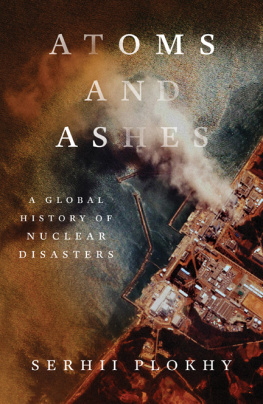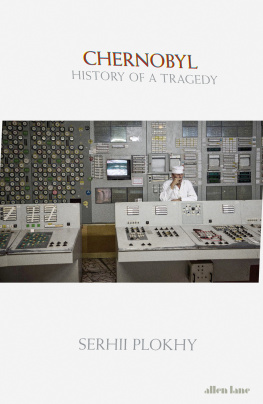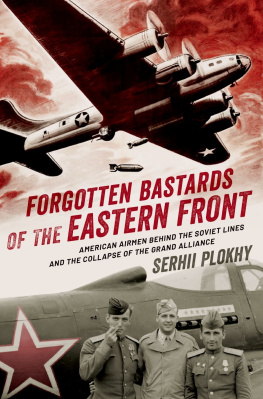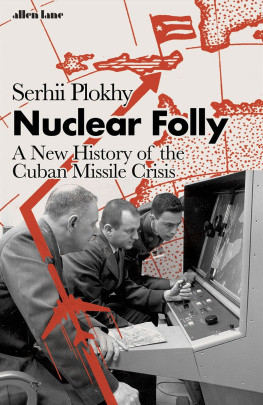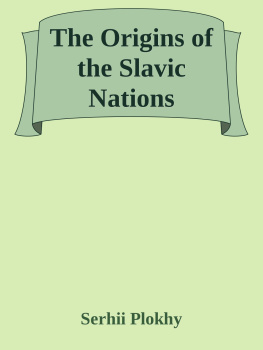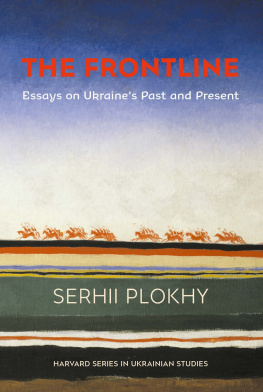Serhii Plokhy - Atoms and Ashes : A Global History of Nuclear Disasters
Here you can read online Serhii Plokhy - Atoms and Ashes : A Global History of Nuclear Disasters full text of the book (entire story) in english for free. Download pdf and epub, get meaning, cover and reviews about this ebook. publisher: W W Norton & Co Inc, genre: Art. Description of the work, (preface) as well as reviews are available. Best literature library LitArk.com created for fans of good reading and offers a wide selection of genres:
Romance novel
Science fiction
Adventure
Detective
Science
History
Home and family
Prose
Art
Politics
Computer
Non-fiction
Religion
Business
Children
Humor
Choose a favorite category and find really read worthwhile books. Enjoy immersion in the world of imagination, feel the emotions of the characters or learn something new for yourself, make an fascinating discovery.
- Book:Atoms and Ashes : A Global History of Nuclear Disasters
- Author:
- Publisher:W W Norton & Co Inc
- Genre:
- Rating:5 / 5
- Favourites:Add to favourites
- Your mark:
- 100
- 1
- 2
- 3
- 4
- 5
Atoms and Ashes : A Global History of Nuclear Disasters: summary, description and annotation
We offer to read an annotation, description, summary or preface (depends on what the author of the book "Atoms and Ashes : A Global History of Nuclear Disasters" wrote himself). If you haven't found the necessary information about the book — write in the comments, we will try to find it.
Atoms and Ashes : A Global History of Nuclear Disasters — read online for free the complete book (whole text) full work
Below is the text of the book, divided by pages. System saving the place of the last page read, allows you to conveniently read the book "Atoms and Ashes : A Global History of Nuclear Disasters" online for free, without having to search again every time where you left off. Put a bookmark, and you can go to the page where you finished reading at any time.
Font size:
Interval:
Bookmark:

ATOMS
AND
ASHES
A GLOBAL HISTORY OF
NUCLEAR DISASTERS
Serhii Plokhy

W.W. NORTON & COMPANY
Independent Publishers Since 1923
ALSO BY SERHII PLOKHY
The Frontline: Essays on Ukraines Past and Present
Nuclear Folly: A History of the Cuban Missile Crisis
Forgotten Bastards of the Eastern Front:
American Airmen Behind the Soviet Lines and the
Collapse of the Grand Alliance
Chernobyl: The History of a Nuclear Catastrophe
Lost Kingdom: The Quest for Empire and the Making of the Russian Nation
The Man with the Poison Gun: A Cold War Spy Story
The Gates of Europe: A History of Ukraine
The Last Empire: The Final Days of the Soviet Union
The Cossack Myth: History and Nationhood in the Age of Empires
Yalta: The Price of Peace
Ukraine and Russia: Representations of the Past
The Origins of the Slavic Nations: Premodern Identities in Russia, Ukraine, and Belarus
Unmaking Imperial Russia: Mykhailo Hrushevsky and the Writing of Ukrainian History
Tsars and Cossacks: A Study in Iconography
The Cossacks and Religion in Early Modern Ukraine
ATOMS AND ASHES

The contour lines show the doses accumulated by humans 96 hours after the Castle Bravo test. The doses are shown in rads, a unit measuring absorbed radiation roughly equal to roentgen, a legacy unit of ionizing radiation used at the time of the accident.
For Jude and Auggie
Bikini Atoll: Radioactive fallout after the Castle Bravo test, 1954
Kyshtym: Radioactive fallout after the 1957 accident
Windscale: Radioactive fallout on October 13, 1957
Three Mile Island: Radioactive plume produced by the March 1979 accident
Chernobyl: Radioactive fallout on May 3, 1986
Fukushima: Radioactive fallout, April 2011
R adiationthe emission or transmission of energycomes in a variety of forms. The ionizing radiation produced by nuclear explosions and accidents carries enough energy to detach electrons from atoms and molecules. It combines electromagnetic radiation, including gamma rays and X-rays, with particle radiation, which consists of alpha and beta particles and neutrons.
There are three different ways of measuring ionizing radiation. First is the radiation emitted by the radioactive object, the second determines the level absorbed by the human body, and the third estimates the amount of biological damage caused by the absorption of radiation. Each of these categories has its own unit of measure, and in all cases old units are gradually being replaced by new ones in the International System of Units (SI). A unit of emitted radiation, formerly known as the curie, has been replaced by the becquerel (Bq), with 1 curie equaling 37 gigabecquerels (GBq). The older unit of radiation absorption, the rad, has been replaced with an SI unit called the gray (Gy), which equals 100 rads. Biological damage, formerly measured in rem, has been replaced by the SI unit known as the sievert (Sv).
Different units were used to measure the radiation impact of the six accidents described in this book. The first dosimeters measured radiation exposure in micro-roentgens per second. Converting old units of measure into new SI units is cumbersome, with rem being a welcome exception: rem stands for roentgen equivalent man and is equal to 0.88 of a roentgen, a legacy unit used to measure exposure to the ionizing electromagnetic radiation produced by X-rays and gamma rays; 100 rem equal 1 sievert and, in measuring gamma and beta radiation, amount to 1 gray. Today, 10 rem, or 0.1 Sv, is the standard five-year limit of biological damage sustained by nuclear industry workers in the West.
A statue of Prometheus, a Greek Titan who stole fire from the gods and gave it to humankind as a gift, was erected in the city of Prypiat a few years before the Chernobyl nuclear disaster of 1986. Half-naked, rising from his knees and releasing the unruly tongues of fire into the air, Prometheus symbolized the victory of humanity over the forces of nature and its ability to wrest from the gods their secrets about the creation of the universe and the structure of the atom.
The bronze monument, six meters tall, survived the explosion of the nuclear reactor on the night of April 26, 1986, and the subsequent catastrophe, but it changed location and symbolism. It now stands before the entrance to the office of the Chernobyl nuclear power station and is the centerpiece of the public space dedicated to the memory of the plant operators, firefighters, and other first responders who sacrificed their lives in the battle with the fire and radiation unleashed by the explosion. The Prometheus of the monument turned out not to have control of the fire he unleashed and serves today as a symbol of human
The relocation and transmutation of the meaning of this Chernobyl Prometheus provides a sad but telling metaphor of changed attitudes toward nuclear energy in many parts of the world, some of which have survived nuclear accidents, while others have been fortunate or prudent enough to avoid them. Nuclear weapons, or atoms for war, have never been favorably regarded by the world at large, starting with their first use in the bombings of Hiroshima and Nagasaki in August 1945. But nuclear energy per se, or atoms for peace, as President Dwight Eisenhower called it in his famous speech to the United Nations in 1953, raised high hopes and had a good reputation throughout the world at the height of the nuclear industry in the 1960s and 1970s.
Eisenhower promised to take this weapon out of the hands of soldiers and put it into the hands of those who will know how to strip its military casing and adapt it to the arts of peace. His goal was to reassure the American and world public about the safety of the growing American nuclear arsenal, stop the proliferation of nuclear weapons, and promote world economic development. Following President Eisenhower, Lewis Strauss, the chairman of the US Atomic Energy Commission, declared in the fall of 1954 that atoms would deliver electrical energy too cheap to meter. Many believed that it would also heal diseases, help keep houses warm with every home having its own atomic power plant, dig channels, and power not only submarines and icebreakers but also ships and locomotives.
The nuclear industry has indeed made a major contribution to our lives, most notably in the production of electricity. Today, almost seventy years after the Atoms for Peace speech, with 440 nuclear reactors operating throughout the world, nuclear power provides about 10 percent of world electricity. That is a considerable amount but hardly a game changer. The main reason why atoms for peace have not delivered on their original promise is economic. In North America and Europe today, if one counts direct and indirect costs, nuclear-generated electricity costs more per unit than electricity produced not only by fossil fuels such as coal or gas, but also by renewableswater, wind, and solar.
The main economic argument against nuclear energy that affects the cost per unit of electricity is the cost of building a nuclear power plant. It now costs at least $112.00 per megawatt to build a nuclear plant, as compared to $46.00 for solar, $42.00 for gas, and $30.00 for a wind farm. With the construction of nuclear plants taking as long as ten years, and returns on investment realized incrementally over decades, it is difficult if not impossible to develop nuclear energy without government subsidies and guarantees. That was true back in the 1950s and remains true today. The existing nuclear industry is an open-ended liability. Nobody ever fully decommissioned (as opposed to shutting down) a nuclear power station. We do not know how much that process would cost in total, but there are good reasons to believe that it would be more than the original construction.
Next pageFont size:
Interval:
Bookmark:
Similar books «Atoms and Ashes : A Global History of Nuclear Disasters»
Look at similar books to Atoms and Ashes : A Global History of Nuclear Disasters. We have selected literature similar in name and meaning in the hope of providing readers with more options to find new, interesting, not yet read works.
Discussion, reviews of the book Atoms and Ashes : A Global History of Nuclear Disasters and just readers' own opinions. Leave your comments, write what you think about the work, its meaning or the main characters. Specify what exactly you liked and what you didn't like, and why you think so.

